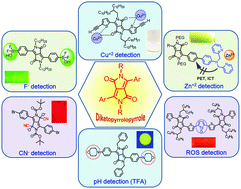Diketopyrrolopyrrole: brilliant red pigment dye-based fluorescent probes and their applications
Abstract
The development of fluorescent probes for the detection of biologically relevant species is a burgeoning topic in the field of supramolecular chemistry. A number of available dyes such as rhodamine, coumarin, fluorescein, and cyanine have been employed in the design and synthesis of new fluorescent probes. However, diketopyrrolopyrrole (DPP) and its derivatives have a distinguished role in supramolecular chemistry for the design of fluorescent dyes. DPP dyes offer distinctive advantages relative to other organic dyes, including high fluorescence quantum yields and good light and thermal stability. Significant advancements have been made in the development of new fluorescent probes based on DPP in recent years as a result of tireless research efforts by the chemistry scientific community. In this tutorial review, we highlight the recent progress in the development of DPP-based fluorescent probes for the period spanning 2009 to the present time and the applications of these probes to recognition of biologically relevant species including anions, cations, reactive oxygen species, thiols, gases and other miscellaneous applications. This review is targeted toward providing the readers with deeper understanding for the future design of DPP-based fluorogenic probes for chemical and biological applications.


 Please wait while we load your content...
Please wait while we load your content...